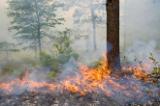Spark of Life: Fire in Florida by Rob Sheppard
The news media seem to love a fire, especially big wildfires. Editors and news directors get great, graphic images, both still and video, reporters find dramatic stories from firefighters and threatened homeowners, and there is always the opportunity for cool maps. Fire makes it easy to get people to watch.
There's no question that big fires are dramatic and scary, but it is the out-of-control fires that get all the press. Unfortunately, this can make people think that fires are all bad. Fire has actually played a critical role in the evolution of the Florida landscape and is an fundamental part of its ecology in many places. In these settings, fire does not have to be -- and, in fact, should not be -- raging and out of control.
This is especially true for pine flatwoods native to western Florida's Panhandle, where the largest remnants of the southeast's longleaf pine and wiregrass natural communities are found. The pines, wiregrass, and their associated species evolved within a fast fire cycle that recurs as quickly as every one to three years. Fire cleans out the riffraff, so to speak, and makes this community stronger and healthier.
When you go to a healthy longleaf pine and wiregrass savannah, you immediately sense how this special place differs from the dense, overgrown hardwoods and pine common elsewhere. Its openness is striking: pines tower above you but do not cover the sky. Its soaring spaces make you feel like you are moving throgh some Gothic cathedral. Below is the wiregrass along with assorted small trees and shrubs. Turkey oak is very common, but fires keep it short. Blueberries and scrub oaks never get very tall, and both are adapted to fire.
When fire is removed from this ecosystem, lots of stuff intrudes on the open space and starts growing there. This is what you typically see alongside the freeway as you drive through northern Florida. Lots of hardwoods unaccustomed to fire start growing and flourishing. They fill up the space between the pines, shade out the wiregrass, and create a riotous mess of a plant community. You feel claustrophobic trying to get through such spaces.
Fire must be part of these systems In order to preserve the integrity of many Florida landscapes. This isn't meant to suggest random, crazy-burning wildfires that threaten people's homes and lives, snarl interstate traffic, and pour smoke into the otherwise blue skies. While such fires were probably not unheard of in Florida's past, there is no place for them today. In addition, they probably occur a lot more frequently today because of people setting them either deliberately or by accident. And big wildfires can be very damaging, even to the ecosystems that depend on them.
Prescribed fires are different in kind, not degree: well-managed fires can keep longleaf pine and wiregrass communities healthy and intact. In fact, areas that burn regularly are unlikely to become raging, out-of-control wildfires.
Prescribed burns occur under very controlled circumstances under of the watchful eyes of specially trained crews, who are both land managers and firefighters. The wind can't be too strong and has to be from the right direction; humidity must be up optimal; and the burn crew works to set and monitor fires with precision -- otherwise, the burn is postponed. The window for prescribed burning can be so precise, in fact, that when the conditions finally cooperate, the burn crews drop everything else and get to work.
It's fascinating to observe a prescribed burn move through a longleaf savannah from up close. The fire creeps along the ground, burning the plant life in its way, and releasing a lot of smoke. As the fire hits certain patches of brush, it flares up dramatically. An abundance of flammable material in blueberries, for example, causes them flame up boldly.
But the fire has very little effect on longleaf pines, other than singeing their outer bark. What's really cool is the way that the 12-inch-long needles often burn at the ends but snuff out quickly without burning down to the growing points, protecting young plants.
Other native species respond differently, but respond nonetheless. Wiregrass burns to the ground, but its growing points underground remain unaffected. The tops of turkey oaks suffer damage but survive, growing up again from below the soil if they have to, and blueberries likewise recover just fine. Scrub oaks, meanwhile, weather the low-heat scalding of a regularly burned savannah with little outward effect.
But woody species, be they native or invasive, can't handle the flames and die off. This maintains the flatwoods' natural openness and allows the native residents -- red-cockaded woodpecker, gopher tortoise, and others -- to prosper. In addition, the fire restores nutrients to these often poor or sandy soils and even stimulate the germination and growth of plants unique to these areas.
Modern Florida has had an uneasy relationship with fire, despite the hand it's played in shaping its landscapes. People like to build houses out into the state's wild areas, because they crave connection to natural aesthetic of the Florida landscape . This instinct, of course, also puts them closer to fire. As we now know, human communities that move further into these lands cannot do so without having an effect on them.
When we recognize the importance of fire to the landscape and plan accordingly, we can coexist with Florida's incendiary nature. By preserving this primal natural disturbance and minimizing its danger, we can help protect and enhance what makes Florida, Florida.
Writer, photographer, and speaker Rob Sheppard edited Outdoor Photographer for many years until recently and continues there as editor-at-large. A trained naturalist and author of more than 20 photo books, he is also former editor of PC Photo, and his work has been published in magazines ranging from National Geographic to The Farmer.







